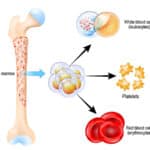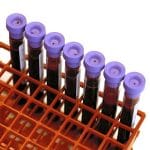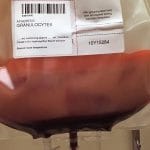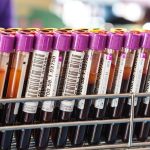“Wow! I never even heard about that article!” Two authors of a great synopsis of 2016-17 critical developments are here to help you get caught up!
NOTE: Continuing Education credit for this episode has expired. See below for details.

Dr. Claudia Cohn and Dr. Melissa Cushing
Every year, the AABB Clinical Transfusion Medicine Committee develops a detailed synopsis of recent developments in Transfusion Medicine to present to the AABB Governing Board. This year, for the first time, that summary is available to the rest of us! Drs Claudia Cohn and Melissa Cushing (along with Ellen Klapper and James Kelley) edited a condensed version published in Transfusion in April 2018, and they are here to guide you through what you might have missed!
Critical developments of 2016-17
Claudia and Melissa will give you the highlights in seven key areas of Transfusion Medicine:
- Reversal of bleeding in hemophilia and for patients on direct oral anticoagulants (begins at 9:25)
- Duration of RBC storage (16:15)
- Pathogen inactivation/reduction (25:45)
- Blood donor characteristics and patient outcomes (33:25)
- Pediatric transfusion medicine (39:00)
- Transfusion approach to hemorrhagic shock (43:50)
- Therapeutic apheresis and extracorporeal photopheresis (50:25)
Bonus Content!
Please download a one page summary from this article that describes all the developments discussed in this episode (Courtesy of AABB and Wiley Publishing).
About My Guests:
Claudia Cohn, MD PhD earned her PhD in Immunology and Infectious Diseases from the Johns Hopkins University, and subsequently earned her MD at Louisiana State University. After finishing her Transfusion Medicine fellowship at University of California, San Francisco, Dr. Cohn joined the faculty at the University of Minnesota, in Minneapolis, where she is Medical Director of the Blood Bank, Associate Medical Director of the HLA lab and Associate Head of Labs. Dr. Cohn’s research interests include clinical platelet transfusions; patient blood management and applying technology to enhance laboratory utilization efforts.
Melissa Cushing, MD attended Duke University, Georgetown University School of Medicine, Emory University School of Medicine for Clinical Pathology Residency Training, and John Hopkins School of Medicine for her Transfusion Medicine Fellowship. She is an Associate Professor of Clinical Pathology and Laboratory Medicine at Weill Cornell Medical College in New York City, and Associate Director of the Clinical Laboratories and the Director of Transfusion Medicine and Cellular Therapy at New York-Presbyterian Hospital, Weill Cornell Campus. Dr. Cushing’s areas of expertise include the treatment of perioperative bleeding, patient blood management, and innovation in transfusion medicine.
Continuing Education Expired
This podcast episode offered continuing education credit for two years from its release date, but is no longer eligible for such credit.
To find Blood Bank Guy Essentials Podcast episodes with active continuing education opportunities, Click here or visit Transfusion News Continuing Education on Wiley Health Learning.
DISCLAIMER: The opinions expressed on this episode are those of my guests and I alone, and do not reflect those of the organizations with which any of us is affiliated. Neither Dr. Cohn nor I have any relevant financial disclosures. Dr. Cushing discloses consulting fees from Octapharma, Instrumentation Laboratory, and Cerus.
Conflicts of interest have been identified and resolved in accordance with John Wiley & Sons, Inc.’s Policy on Activity Disclosure and Conflict of Interest. The primary resolution method used was peer review and review by a non-conflicted expert.
Further Reading:
- Reversal of bleeding in hemophilia and for patients on direct oral anticoagulants
- Oldenburg J et al. Emicizumab prophylaxis in Hemophilia A with inhibitors. N Engl J Med 2017;377:809-818
- Connolly SJ et al. Andexanet Alfa for Acute Major Bleeding Associated with Factor Xa Inhibitors. NEJM 2016;375:1131-1141
- Pollack CV et al. Idarucizumab for Dabigatran Reversal – Full Cohort Analysis. NEJM 2017;377:431-441
- Duration of RBC storage
- Heddle NM et al. Effect of short-term vs. long-term blood storage on mortality after transfusion. N Engl J Med. 2016;375(20):1937-1945
- Chai-Adisaksopha C et al. Mortality outcomes in patients transfused with fresher versus older red blood cells: a meta-analysis. Vox Sanguinis 2017;112(3):268-278
- Pathogen inactivation/reduction
- Allain J-P et al. Effect of Plasmodium inactivation in whole blood on the incidence of blood transfusion-transmitted malaria in endemic regions: the African Investigation of the Mirasol System (AIMS) randomised controlled trial. Lancet 2016;387:1753-61
- Rebulla P et al. Clinical effectiveness of platelets in additive solution treated with two commercial pathogen-reduction technologies. Transfusion 2017;57:1171-83
- van der Meer PF et al. Riboflavin and UV light treatment of platelets: a protective effect of platelet additive solution? Transfusion 2015;55:1900-8
- Estcourt LJ et al. Pathogen-reduced platelets for the prevention of bleeding. Cochrane Database Syst Rev 2017;7:CD009072
- Blood donor characteristics and patient outcomes
- Tynell E et al. Should plasma from female donors be avoided? A population-based cohort study of plasma recipients in Sweden from 1990 through 2002. Transfusion. 2010;50:1249-56
- Edgren G et al. Association of Donor Age and Sex With Survival of Patients Receiving Transfusions. JAMA Intern Med. 2017 Jun 1;177(6):854-860. doi: 10.1001/jamainternmed.2017.0890
- Pediatric transfusion medicine
- Keir A et al. Adverse effects of red blood cell transfusions in neonates: a systematic review and meta-analysis. Transfusion 2016;56:2773-80
- New HV et al. Guidelines on transfusion for fetuses, neonates and older children. Br J Haematol 2016;175:784-828
- Transfusion approach to hemorrhagic shock
- CRASH-2 Trial Collaborators et al. Effects of tranexamic acid on death, vascular occlusive events, and blood transfusion in trauma patients with significant haemorrhage (CRASH-2): a randomised, placebo-controlled trial. Lancet 2010;376: 23-32
- Holcomb JB et al. Transfusion of plasma, platelets, and red blood cells in a 1:1:1 vs a 1:1:2 ratio and mortality in patients with severe trauma: the PROPPR randomized clinical trial. JAMA 2015;313: 471-82
- Meyer DE et al. Every minute counts: Time to delivery of initial massive transfusion cooler and its impact on mortality. J Trauma Acute Care Surg 2017;83: 19-24
- Therapeutic apheresis and extracorporeal photopheresis
- Peyvandi F et al. Caplacizumab for acquired thrombotic thrombocytopenic purpura. N Engl J Med 2016;374:511-22
Music Credit
Music for this episode includes “Cuando te invade el temor” and “Reflejo,” both by Mar Virtual via the Free Music Archive. Click the image below for permissions and license details.














Thanks for another great podcast! You may be interested to know that I only interrupted my weekend of tribute to the late Aretha Franklin to listen to bbguy podcasts✌🏾
Also, we switched PAS platelets recently. I found it interesting that findings suggest that the platelet count increment is lower in patients who receive PAS platelets. Is there any more info on this? Thanks!
I feel a combination of happy and sad hearing Aretha mentioned, Velvet. Her music was always very personal to me as a fellow Detroiter. She was amazing, and I’m so sad she’s gone.
The data is somewhat mixed that I’ve seen on PAS platelets and decreased response. Historically, I think most believed that the Corrected Count Increment (CCI, measuring standardized response) was less with PAS platelets, but I don’t think there was a ton of data to support that. At Johns Hopkins, they found less response at 1-4 hours but the same at 24 hours (you can read the abstract of their article here). My opinion at this point: Probably some decrease but unclear that the decreased response means anything clinically. Check this article for a nice current summary of thoughts on PAS.
-Joe
Really impressed with the European blood centers able to figure out the gender and age of donors. Will ISBT labels eventually have those information? Even though the results are not definitive, an interesting concept.
Used to joke with friends that Blood Bank is the most racist and homophobic section of the lab, now I can add sexist and age discrimination to the list. Just kidding..